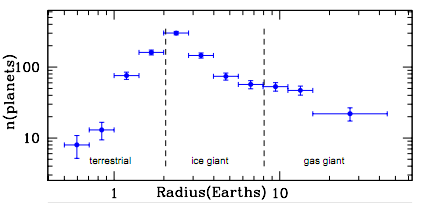Authors: Kaitlin M. Kratter, Ruth A. Murray-Clay, and Andrew N. Youdin
First Author’s Institution: Department of Astronomy and Steward Observatory, University of Arizona
Status: Published in the Astrophysical Journal [open access], available on the arxiv
Even though we live on a planet, we still don’t have a firm understanding of how planets, even our own, are formed. One of the more popular models for building planets is known as the standard core accretion model. In this model, miniature planets (known as planetesimals) are located within a disk of gas surrounding a central star. The planetesimals collide and stick to each other, forming a larger core which accretes the surrounding gas, eventually forming a planet.
Up until 2010, this model had really only been explored and tested up to ~10 Astronomical Units (AU) away from the central star. At larger distances, there was a bit of a wild west with respect to how planets form, especially in a well-studied planetary system known as HR 8799. HR 8799 consists of four objects each ~10x the mass of Jupiter orbiting a central star at distances between 30 and 70 AU. (HR 8799 is also discussed in these three other astrobites.) With current theories unable to explain the locations of the planets in HR 8799, the authors of this paper explore a new mechanism for forming the planets in HR 8799: gravitational instability.
How do we get gravitational instability?
In the gravitational instability (GI) model, part of the gas disk surrounding the central star breaks apart and forms companion objects. Under certain circumstances, these companion objects can evolve to become planets!
To achieve GI, we need the disk to be unstable to a parameter known as the Toomre Q which compares forces from gravity, pressure, and shear. In general, a disk is unstable to this parameter (and will break down) if it is cool and has small differential rotation (the difference between the rotation at different radii). This occurs towards the outer edge of the gas disk.
Additionally, the disk must be cooling very rapidly. One way of thinking about this is that if the disk does not cool fast enough, the heat within the disk will induce an outward pressure force and prevent the disk from gravitationally collapsing (since pressure counteracts gravity) .
Using these two criteria and some estimated disk parameters such as the temperature within the disk, the authors model the mass of the fragments that form from GI in order to determine whether GI is a viable way of forming the planets in HR 8799.
What did they find?
The authors’ model for GI predicts the mass of the companion and its distance from the central star are related. This is shown below in Fig. 1 by the grey shaded region. The grey line is close to but never reaches the three black circles, which represent the observed masses and radii of three of the planets in HR 8799. In order for this grey line to extend to these radii and masses, and thus allow GI to produce companions such as those in HR 8799, two things would need to happen: 1. the planets would need to form at larger radii and migrate inwards and 2. the authors would need to severely adjust the parameters they use to model the disk. However, it is not clear if the necessary parameters are physically possible. It is also important to note that if the planets exceed 13 Jupiter masses, they reach the deuterium burning limit. At this point, the objects will start to burn deuterium at their center and will no longer form planets but rather substellar objects such as brown dwarfs. These are objects that are heavier than planets, but not heavy enough to fuse hydrogen in their core and become a star. Thus, the companions predicted by the model are right on the line of being either planets or substellar objects such as brown dwarfs.
How does HR 8799 fit into the larger picture?
In Fig. 1, the masses in the grey region tend to be larger than ~13x the mass of Jupiter, which indicates a substellar object instead of an exoplanet. So, if planets can form from GI, they would be the low-mass end of a distribution that formed from GI. Given this, the authors compare the mass ratio and projected separation of all known substellar companions and exoplanets (see Fig. 2). However, as indicated by the two, empty grey boxes in Fig. 2, there is not enough data to determine which distribution HR 8799 comes from.
Putting all of their work together, the authors find it challenging (although not impossible) to reproduce the HR 8799 system using GI. It is possible that planets formed through GI might just be the lower end of a distribution of objects formed from GI. If a population of planets formed from GI do exist, then we would expect to find a large number of substellar objects surrounding A type stars. Thus, this work (while dating back to 2010) set the stage for future exoplanet and low mass object surveys to test this hypothesis! Investigation into this hypothesis is still ongoing, as more systems similar to HR 8799 are discovered, and larger studies are used to determine whether the property distributions of planets and substellar objects are different.
Astrobite edited by Jana Steuer and Briley Lynn Lewis.
Featured image credit: Universe Today




